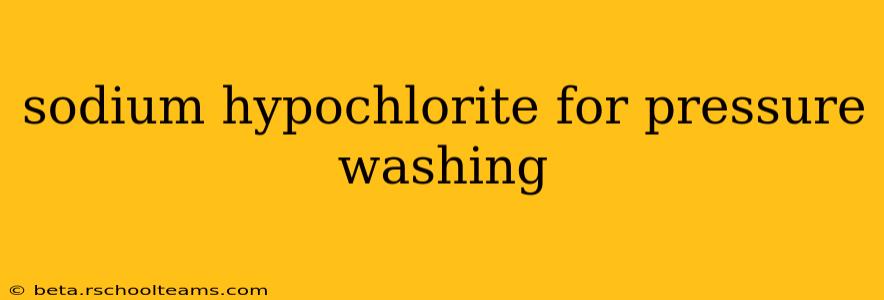Sodium hypochlorite, commonly known as bleach, is a potent disinfectant and cleaning agent often used in pressure washing applications. Its effectiveness against a wide range of contaminants makes it a popular choice for various cleaning tasks, from removing mold and mildew to disinfecting surfaces. However, understanding its proper application and safety precautions is crucial for achieving optimal results and avoiding potential hazards. This comprehensive guide will explore the uses, benefits, and safety considerations of using sodium hypochlorite in pressure washing.
What is Sodium Hypochlorite and How Does it Work in Pressure Washing?
Sodium hypochlorite is a chemical compound that, when diluted in water, releases hypochlorous acid. This acid is a powerful oxidizing agent, meaning it breaks down organic matter by stripping electrons. This process effectively kills bacteria, viruses, fungi, and algae, making it an ideal disinfectant for various surfaces. In pressure washing, the high-pressure water stream combined with the disinfecting power of sodium hypochlorite creates a highly effective cleaning solution. The pressure helps to dislodge dirt and debris, while the bleach penetrates and eliminates contaminants.
What are the Benefits of Using Sodium Hypochlorite in Pressure Washing?
- Effective Disinfection: Sodium hypochlorite is highly effective at killing a wide range of microorganisms, making it ideal for disinfecting surfaces prone to bacterial growth, such as patios, decks, and driveways.
- Mold and Mildew Removal: Its oxidizing properties make it excellent for removing mold and mildew, common problems in damp or humid environments.
- Stain Removal: Sodium hypochlorite can effectively remove various stains, including those caused by organic matter like algae and mildew.
- Cost-Effective: Bleach is a relatively inexpensive cleaning agent compared to other commercial disinfectants, making it a budget-friendly option.
What Types of Surfaces are Suitable for Pressure Washing with Sodium Hypochlorite?
While effective, sodium hypochlorite is not suitable for all surfaces. Its bleaching properties can damage or discolor certain materials. Always test a small, inconspicuous area before applying to the entire surface. Suitable surfaces generally include:
- Concrete: Driveways, patios, sidewalks
- Brick: Walls, patios
- Vinyl siding (with caution): Test in an inconspicuous area first.
- Decks (wood): Use caution and dilute the solution appropriately.
What are the Safety Precautions When Using Sodium Hypochlorite for Pressure Washing?
- Dilution is Crucial: Never use full-strength bleach. Always dilute it according to the manufacturer's instructions and the specific cleaning task. Over-dilution is better than under-dilution.
- Protective Gear: Always wear appropriate protective gear, including gloves, eye protection, and a respirator, to prevent skin and respiratory irritation.
- Ventilation: Ensure adequate ventilation in the area where you're using bleach.
- Avoid Mixing with Other Chemicals: Never mix sodium hypochlorite with ammonia or acids, as this can create toxic gases.
- Environmental Considerations: Avoid runoff into storm drains or water bodies.
- Storage: Store bleach properly in a cool, dry place, away from children and pets.
How to Properly Dilute Sodium Hypochlorite for Pressure Washing?
The appropriate dilution ratio depends on the specific cleaning task and the concentration of the bleach. Generally, a 10% solution (1 part bleach to 9 parts water) is suitable for most applications. However, it's always best to consult the manufacturer's instructions on the bleach bottle and adjust the dilution based on the surface and the level of soiling.
What are the Potential Risks of Using Sodium Hypochlorite in Pressure Washing?
While effective, using sodium hypochlorite involves some risks:
- Skin and Eye Irritation: Direct contact can cause irritation or burns.
- Respiratory Problems: Inhalation of bleach fumes can cause respiratory irritation.
- Environmental Damage: Improper disposal or runoff can harm the environment.
- Material Damage: Bleach can damage or discolor certain materials.
How Do I Dispose of Sodium Hypochlorite Safely After Pressure Washing?
Always follow local regulations for disposal. Never pour unused bleach down the drain. Instead, allow the diluted solution to fully react on the cleaned surface before rinsing thoroughly. You may need to neutralize any remaining solution before disposal.
Is Sodium Hypochlorite Effective Against All Types of Stains and Contaminants?
While sodium hypochlorite is effective against many stains and contaminants, it may not be effective against all types. For example, oil-based stains may require a different cleaning agent.
Can I Use Sodium Hypochlorite on All Types of Pressure Washers?
Sodium hypochlorite can be used with most types of pressure washers, but always ensure the pressure washer is compatible with the cleaning solution and check the manufacturer's recommendations.
By following these guidelines and safety precautions, you can harness the power of sodium hypochlorite for effective and safe pressure washing. Remember, proper dilution and protective gear are essential for both successful cleaning and personal safety.
